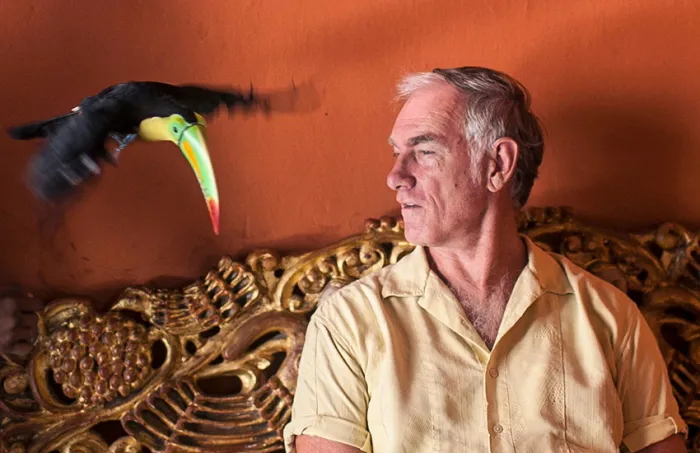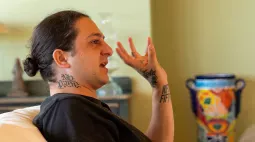'I didn't need to fake it' - John Sayles, writer director

Before the college reunion classic Big Chill there was the college reunion classic Return of the Secaucus Seven. Before Matthew McConaughey with a badge in True Detective there was Matthew McConaughey with a badge in Lone Star. Before the celebrated independents there were the uncelebrated independents. Before Jim Jarmusch there was John Sayles. Sayles is the guy whose name might sound familiar to many but whose films are mostly appreciated by the art house circle and the filmmaker wannabes who would gladly max out dad’s credit card to make a nobudget movie. Sayles is often called America’s best unknown director a title he holds dear to his heart. The Cartagena Film Festival is holding a retrospective screening of John Sayle’s films. All the more reason to ask the man himself how he came to be the father of American independent cinema while all along working behind the scenes for the big Hollywood studios making uncredited script work or as they say script polish.
Magyar Narancs: You started out as a screenwriter in the seventies writing B-movies for the king of B-movies, producer Roger Corman. Probably your biggest achievement from this period is writing the horror-quickie Piranha. How did that come about?
John Sayles: It’s not really a horror movie. It’s a monster movie. It’s a special genre. Like the movie Them! which was giant ants. Or King Kong, Godzilla and so on. They have a very definite arch to them. So I rewrote one of my own stories in 2 or 3 weeks and that got made and became one of Roger Corman’s most successful movies. That was Piranha. So Corman hired me to write a couple of other things. One was The Battle Beyond the Stars which is basically Seven Samurai in space. Then came Lady in Red which is a gangster movie. And then several directors I met there, when they started getting work outside of Corman’s studio, they asked me to come and write things like the The Howling or Alligator. So I had the luck that almost no screenwriters have which is of the first 6 or 7 movies I wrote, all of them got made. In a way I learned what worked and what didn’t and also I learned to recognize what you really needed money for to do well and what you could do well just by imagination and hard work.
MN: What was the most precious advice you got from Corman?
JS: Unlike working for the studios where the notes are very vague a lot of Corman’s notes were about the rhythm of the genre. Like a note said on page 56 it’s too early to have another attack. You have to have some calm water before the piranhas or the alligators come again. Give the audience time to rest. A lot of them were notes about movie rhythm. I tried to write shooting script so if a computer had directed it, it would still look like a movie. And the other part of it was really about what you can afford to do and what you can’t afford to do. What’s gonna be doable well and what’s not.
MN: With your Seven Samurai in Space movie, how much of the classic Kurosawa film could you sneak into it?
JS: Actually it’s a meditation on death. I didn’t tell Roger Corman that. I had a theme to go through it to help keep it together and that was the Seven Samurai story. What was fun about those movies is they could be very allegorical and fun at the same time.
MN: The Battle Beyond the Stars was a Star Wars ripoff, right?
JS: It was definitely made because Star Wars was popular. Just as Piranha was a spinoff of Jaws. We did a lot of movies like that. One of the things Corman did that was very intelligent: he tested the market with titles. If people had liked the title he made the film. He had already made a movie called Battle Beyond the Sun and whenever he tested audiences with the title Battle Beyond the Stars people always said, yeah I wanna see that movie. It was more of a title searching for a movie than a movie searching for a title. As it turned out the guy who became one of the designers and eventually the production designer of this film was James Cameron. It was one of his first jobs in the art department. Roger got mad one day and fired everybody so he said to Cameron: okay, you are running things now. So there was a lot of that how can we invent something that looks okay for the movie but doesn’t cost anything. So a lot of what Cameron did was take the plastic containers from McDonald’s and spray-paint them black and put them in various things to make the interior of the spaceship and stuff like that which costs almost nothing just work. Nobody got any sleep but that was Roger’s way. And I had to write that way. They hired a few guys from the Star Wars team, really young guys, but at one point the director said what we can’t do with the special effects we have, we can’t show any spaceships taking off or landing. So they are either in space or on the ground. So if they are landing, they are inside. I had to find the way around these things.
MN: Speaking of James Cameron, you wrote a screenplay for him once…
JS: Yes, I wrote a thing…He was producing it but wasn’t going to direct it. It was called Brother Termite which was a science-fiction flick. I hope somebody makes it someday. Great story based on a very good science-fiction book. A couple times I worked for directors who have a lot of resources – I worked for Steven Spielberg a couple times – and then you can just invent anything. And you know even if the technology doesn’t exist they find a way to do it. Whereas working for Roger and some of the other jobs I had it has always been do your best job but it can’t cost too much.
MN: As an independent writer-director you have followed in John Cassavetes’ footsteps. You work for Hollywood, earn money there and finance your own projects with it.
JS: We were both very lucky in that way because most of the independent filmmakers I know don’t have a job that pays that well. I’m not the highest paid screenwriter, John wasn’t the highest paid actor, but it pays much better than teaching or waiting on tables.
MN: Have you crossed paths with Cassavetes?
JS: No, I have never met him but I met some of the people who worked with him. I met Peter Falk once, Seymour Cassel and some of his children I met over the years. He was sick actually in his last couple of years. But I worked with Michael Chapman who shot one of his movies. But it’s interesting that the influence that his movies had on me was more as an actor than a director. Actors were really interested in those movies. The essential Cassavetes theme was people have a hard time communicating. They couldn’t say even the most simple emotional things to each other. It lent itself to the kind of filmmaking where…I think Mike Leigh does something very very much like this where the actors would improvise a scene then they might talk about it and then he writes it. So the movies are scripted but you have that feeling of improvisation. So for actors it was a kind of acting that was very rare to see from Hollywood movies. There wasn’t that snappy dialogue all the time. And then just as a model of that it’s possible to make a movie outside of Hollywood. Somehow Cassavetes and some others got away with it so it seemed like it’s possible.
MN: Your first independent film was Return of the Secaucus Seven. Not only it was your first attempt at independence away from Corman’s constraints but your first time behind the camera as director too. How did it come about?
JS: I have written those movies for Corman and I have written a few for these other directors. In those days Corman was a signatory to the Writers Guild at that point. He isn’t any more. But the minimum was 10 thousand dollars for a screenplay which was a lot of money for me in those days. But he wasn’t a signatory for the Directors Guild so when Joe Dante directed Piranha he got 8 thousand dollars. And when Joe asked what am I gonna do for the soundtrack Roger said, oh, I’ve got some stuff in the library. Music that was public domain and cheap. Joe didn’t like any of that so he just took his own 8 thousand dollars and hired Pino Donaggio, an Italian composer who worked for Brian De Palma. So John basically made nothing. But it helped him get other work (Dante went on to direct Gremlins for Spielberg – ed.) So basically I saved 40 thousand dollars and I figured wow I’ve got 40 thousand dollars I could make a movie. Today that would be 400 thousand.
MN: So what was the biggest lesson for you as a first-time director?
JS: That you have to do your best with what you have. Corman’s motto was: you make it as efficiently and cheaply as possible. It wasn’t a bad advice. Actually Return of the Secaucus Seven is an interesting movie visually, it looks better than I wanted it to look. The crew never worked on a feature film before they had been making commercials. I wanted to have a more documentary look, more rough but they just couldn’t stand it. It was way before all those CSI shows and MTV where the camera can be hand-held and unsteady. But that was the crew I had. And another thing: since none of us had made a feature before if there was a problem I could just say I don’t know. If somebody asked me a question and I didn’t have the answer yet I didn’t need to fake it. I could just say good question – I don’t know now but I figure it out.
MN: I assume you had had all the answers by the time you made Eight Men Out (Sayles’ baseball film about the 1919 Black Sox scandal– ed.) that was financed by a big Hollywood studio.
JS: Not all of them but most of them. It was a long process. It took me 11 years to make that movie. I started out with Martin Sheen and ended up with Charlie Sheen. I thought I might play a ball player but 11 years later I was just too old for that. You know John Huston made The Man Who Would be King with Sean Connery and Michael Caine but he started with Clark Gable and Errol Flynn.
MN: One of the producers you worked a lot over the years as a script-writer is a guy named Spielberg.
JS: I did a movie called Night Skies – he was gonna produce it but not direct it. The last page of that script is the first page of E.T. On the last page of my script there was a bunch of bad E.T.-s and one nice one. And he is the one who gets left behind. They didn’t make that movie but that idea kind of spilled over into E.T. The other thing I did a couple drafts of is Jurassic Park 4. I think they are shooting it right now. I was tinkering with that but that was 7 years ago so who knows what they made it into.
MN: What’s was your take on the Jurassic-sequel?
JS: I can’t tell you because they may have kept it. But it was very different. What was clear to me was you know they weren’t going to drag people back to that island one more time. So I tried to think of how to take this franchise somewhere else and make it kind of new and interesting. Interesting for Spielberg as a producer and also interesting for the audience.
MN: So how is life as a screenwriter for-hire?
JS: As a screenwriter for other directors or producers I am an employee, nothing more. You just can’t get emotionally involved because your work probably won’t get made or gets made but they say one day, we think the woman should be 20 not 40. I worked for John Frankenheimer, a wonderful Hollywood director, and you know, he needed a really fast rewrite on a martial arts film to make it a Samurai-movie. He just said, oh yeah, you know, how the draft you’ve got is all Chinese people – change it to Japanese. You’ve got 3 days to do it. If it had been my story that would have been very upsetting. But as a hired hand it was just a job. I have worked with a lot of interesting directors: Sidney Pollack, Jonathan Demme, Bille August… You know the more I get paid the less likely the movie is gonna get made. Studios develop so many things but they only make a few.
MN: What was your most lucrative job as a hired hand?
JS: I think working on Apollo 13. I was one of the last writers on that even though I didn’t get credit for that. It was a big project, everybody was getting paid a lot. That was the one I made the most money on.






